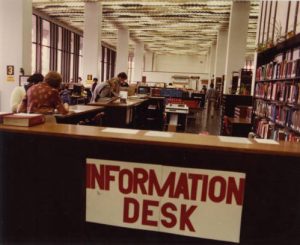
Reference Desk. 1982. Paley Library. From Temple University Libraries, Special Collection Research Center.
Last month I completed six years of service on the editorial board of ACRL’s Academic Library Trends and Statistics Survey. Our meetings involved much discussion on how best to provide clear instructions to survey participants, debates over wording of trends questions, and work with ACRL staff in recruitment efforts to insure a robust response rate (this last year it was 1,676). We focused mostly on new metrics of potential interest, like the number of computers provided by the library. Or new formats for instruction. We didn’t talk much about the definition of a Reference Transaction – a number requested also by the Association of Research Libraries, Association of Academic Health Sciences, and IPEDS, the Integrated Postsecondary Education Data System (more commonly, IPEDS).
The definition all of these surveys use is one modified from the ANSI/NISO Z37.7 definition, updated last in 2004.
An information contact that involves the knowledge, use, recommendations, interpretation, or instruction in the use [or creation of] one or more information sources by a member of the library staff. The term includes information and referral service. Information sources include (a) printed and nonprinted materials; (b) machine-readable databases (including computer-assisted instruction); (c) the library’s own catalogs and other holdings records; (d) other libraries and institutions through communication or referral; and (e) persons both inside and outside the library. When a staff member uses information gained from previous use of information sources to answer a question, the [transaction] is reported as a [reference transaction] even if the source is not consulted again.
Survey instructions make very clear that we do not count “directional” questions, those questions about the “logistical use” of the library. Examples of directional questions are:
- “Which way is the restroom?”
- “Where is the nearest printer?”
Reference is counted when we are “looking up” a piece of information:
- “Does the Library have a copy of Ivanhoe?”
- “What are the library’s hours today?”
Time and complexity don’t really count. ACRL has us distinguish between “reference” and “consultation”, but ARL does not. Some libraries (like ours) define a consultation as a transaction that is complex and takes time. Others count a consultation as transactions for which a patron makes an appointment.
When we tally it all up, should looking up the hours on the library website count the same as a 1-hour consultation on the use of R at the Scholars Studio? Does working with a faculty member on defining the parameters of a systematic review count the same as looking up a known item in Library Search? What about the instruction of a faculty member in how to place an item on reserve in Canvas? ARL counts these the same, although one may take a staff member less than a minute, the other hours. Some reference questions require more training and specialized expertise.
Our patrons are sometimes surprised to learn that behind the “curtain” of our online Chat Service, or our Digital Request Form, a human being is waiting to assist. As my colleagues described so well in the last blogpost, our numbers for reference are exploding, and we have many many thankful patrons helped by expert information searchers using their knowledge of the many information sources available to help them.
But what if that automatically populated form was sent in an automated way to a federated search across the many information resources we provide? And no human was involved? And the patron found just what they were looking for? Would our robot get to count that as a reference question?
What if our easy-to-use FAQ, or our LibAnswers, were so well-developed that a patron’s search query always mapped to the answer they sought? Do we get to count that? Is the only thing that counts a transaction that involves a human being?
There was a time when most reference required the patron go to the physical reference desk. Behind the desk were massive shelves of reference books, non-circulating, and the job of reference was to match the question to the appropriate volume. As a reference librarian, I’d often go to the shelves myself and serve up the book to the [thrilled] patron myself. The dark ages of librarianship!
Perhaps it’s time to rethink how we develop, measure and assess the ways in which our expertise supports the reference services we provide, whether physical or virtual.
